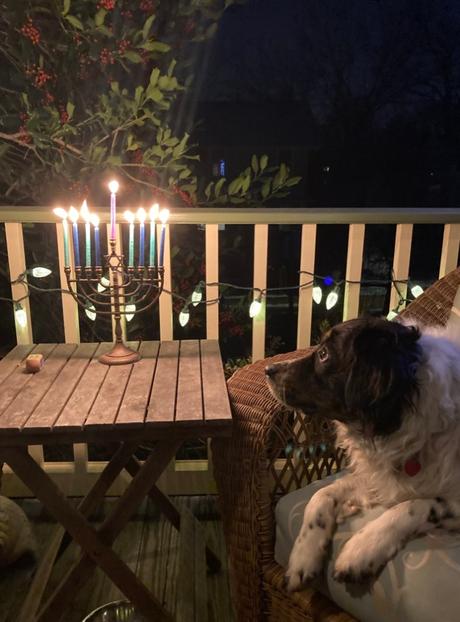 Photo by Susan Katz Miller
Photo by Susan Katz Miller And so we reach that most reductive time of the year, when the choices of Jewish and Christian interfaith families are judged by whether they celebrate Hanukkah, or Christmas, or both, or neither.
In my opinion, this is a poor method for understanding the textured and nuanced lives of interfaith families. To take just one example of our complexity, many "we are Jewish, period" families celebrate Christmas as a sort of cultural exception (in a secular way, or, say, with Christian grandparents). So, the choices an interfaith family makes around "winter holidays" provide only very limited insight into the spirituality, beliefs, practices, and identities of the various family members.
This year (as in every year), a number of families with one Jewish parent and one parent raised Christian are making emphatic statements about why they do not celebrate Christmas. What troubles me about these statements is not the choice these interfaith families made-it's a choice that works for some families. What troubles me is the erasure of the spouse who is not Jewish, whose journey and feelings are rarely acknowledged by Jewish writers in the Jewish press.
One such essay this season is entitled " No, We Don't Celebrate Both." I take this headline as a sort of tribute, in that "doing both" is becoming a more familiar concept in our culture. In this essay, a Jewish mother rejects the label "interfaith family" (and also the label "interracial family"), detailing why she and her husband (who is Black) consider themselves only a Jewish family, and do not celebrate Christmas. She uses the familiar "we are celebrating someone else's birthday" metaphor to explain to her children why, in spite of this decision, they bring Christmas presents to her husband's Christian family. But she does not mention how or why she and her husband negotiated this choice, or the current religious or secular identity of her husband, who grew up Christian, and who seems to have no presence or voice in the essay.
And in the new animated short film " Blewish," the protagonist is a boy with a Jewish mother and a Black father (a father who presumably was not raised Jewish, although we have no idea how he was raised, and of course multigenerational Black Jewish families exist). The boy faces a teacher and classmates who assume he celebrates Christmas, and white Jewish children who do not accept him as Jewish because he is Black, initiating a brief identity crisis. The six-minute film's creator is himself the child of a Jewish mother and a Black father, and grew up in Conservative Judaism.
I love that adult interfaith children are using their voices and creating art and commentary. "Blewish" begins to fill a significant gap, in depicting the experiences of Black and Jewish children from their own perspective rather than from the parents' perspective. But once again, the Black father's religious identity (or even cultural identity) is not represented in the film. Is he an atheist? A convert to Judaism? A practicing Protestant? In Jewish media, and art, the parent of another religious heritage too often remains silent. (Ironically, this is a silent animated film, so everyone remains silent). But my point is that the perspective in this film, like so much written for interfaith kids, is very firmly that of a Jewish family member, minimizing the input or representation of any immediate or extended family members who practice another religion.
One must note how often these stories come to us from families with a Jewish mother-families who feel secure claiming Judaism for children who are "matrilineal" in their Jewishness. The authors of these stories may not be able to fully empathize with the more complex issues facing "patrilineal" Jewish families. All of us with interfaith heritage face the exhausting push and pull of two kinds of statements from society: "You're Not Jewish Enough," and "You're Not Really Jewish." But the calculus of what to do with this unsolicited advice, with these aggressions from inside and outside the Jewish world, plays out differently for matrilineal and patrilineal interfaith Jewish children.
For two decades now, I have been working to increase awareness of the diversity of interfaith families, and of the right for families to choose the practices and identities that work best for them. My second book, The Interfaith Families Journal, is devoted to helping families through this process, whether that means no Christmas, a secular Christmas, or heralding the Christmas angels.
Of these pathways, doing both Hanukkah and Christmas, and being both Jewish and Christian, is a demographically significant choice. A recent study of Jewish Chicago found 21% of interfaith families with one Jewish parent raising children in two religions. In my opinion, this is an underestimate, given that the sampling drew heavily from mailing lists connected to Jewish institutions. (Other studies have found the percentage of interfaith families with one Jewish parent raising kids with both religions to be 44% in Toronto, 46% in western Massachusetts, and 34% in Minnesota's Twin Cities).
Nevertheless, the annual Hanukkah/Christmas skirmish triggers a defensive backlash from people who don't approve of interfaith marriage, or don't approve of choosing both. The wildest year involved a Jewish writer comparing me to a Barbie doll dressed as a "fancy-hot-pants prostitute." Go figure.
We are facing another long, dark winter of trying pandemic times. Let us all strive to be gentle with one another, and find ways to bring light, whether that is the light of Diwali, Hanukkah, Christmas, Yule, or all of them. And let us all work to channel empathy for other interfaith families, and the choices they make.
Journalist is an interfaith families speaker, consultant, and coach, and author of Being Both: Embracing Two Religions in One Interfaith Family (2015), and The Interfaith Family Journal (2019). Follow her on Twitter @susankatzmiller.
